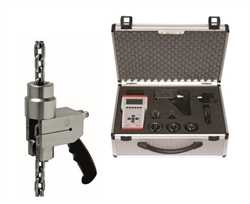Details
Digital amplifiers are used to adjust the mV/V-output signal of strain gauges to a connected control. The model EZE30 comes with an integrated LED-display which allows also to display the measured data immediately. Controllers can be connected through the many interfaces. The amplifier has 3 relay outputs, one analogue output, one serial RS-422/485 interface and 3 logical inputs. The model EZE30 series is designed for lightly dynamic and static applications for example weighing. The user-friendly device for top hat rail mounting comes with big screw-type terminals, a LED-display and keys which can be used to operate the amplifier or to set its parameters.
Features
- Amplifier for strain gauges with LED-Display mountable on top hat rails
- Can be configured via keyboard or PC
- Digital output signal via serial RS-422/RS-485 interface
- Freely programmable analogue output (2-20 mA)
- 3 freely programmable limit contacts
- 3 logical inputs for remote controll
- Limit frequency up to 20 Hz for quasi static applications
- Accuracy 0,002 % of full scale
- Up to 4 strain gauges with 350 ohm parallel connectable
- Supports 6-wire technology
- Bridge supply 5 VDC
- Needed power supply 12-24 VDC
- User friendly and easy to maintain because of big screw-type terminals, keys and LED-Display
- Easy communication via big set of ASCII-commands
- Protection class IP 40
Application
Because of its high accuracy and speed of the A/D converter the amplifier EZE30 suits especially well for weighing but also can be used to measure and monitor forces at engines. Measured data and the status of the in- and outputs are displayed on the 5 digit digital display. It is possible to connect all kinds of strain gauges (max 4 sensors, 350 ohm) with an output signal up to ± 3,2 mV/V. The internal sensor supply is 5 VDC. The internal sensor supply is 5 VDC. Usually the amplifier is not pre-adjusted and the customer connects it to the force transducer and also adjusts it. The amplifier can be programmed either by keyboard or by ASCII-commands via pc. A menu guides the programming. The keys also allow to tare and to set a new zero-point. Through a standard terminal programm it is possible to communicate via the seriel RS-485 interface. A software with oscilloscope function which runs under windows is also available. The 3 relays can be used to monitor if limit values are underran or overtraveled. The analog output, which can also be programmed freely offers a 2-20 mA output signal for analog processing. The many possiblities to adjust filters allow to damp interfering signals.















